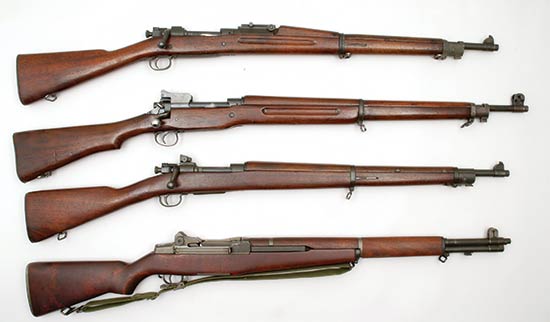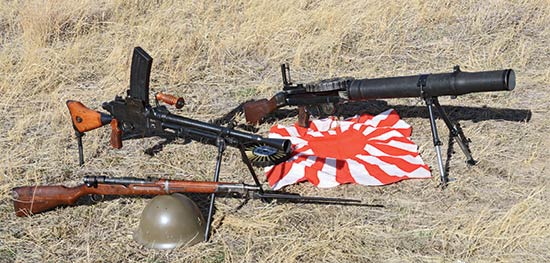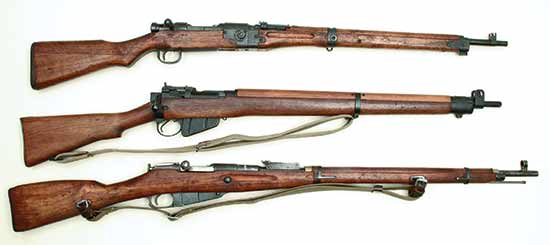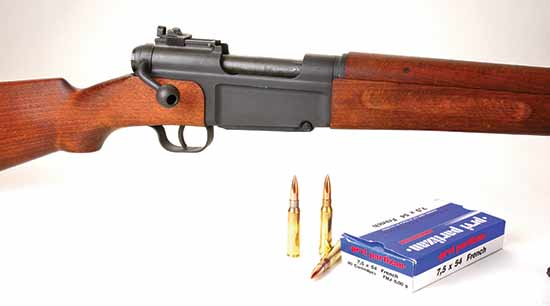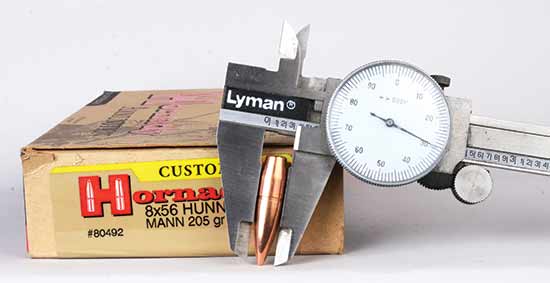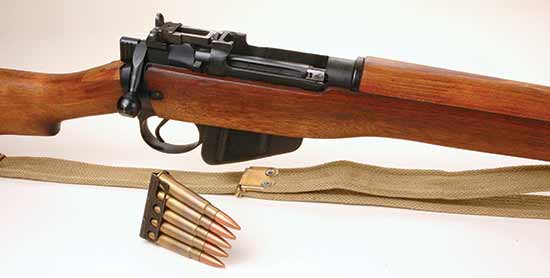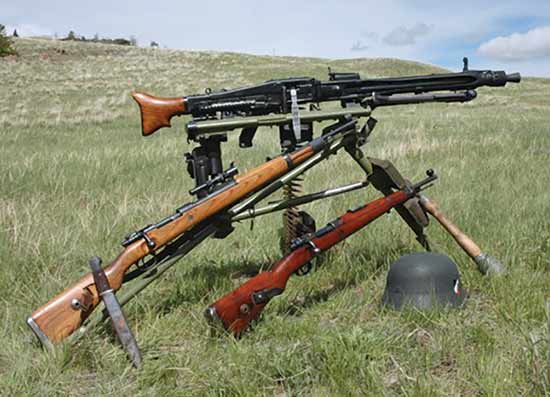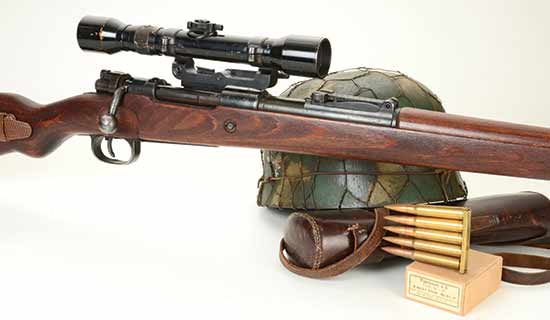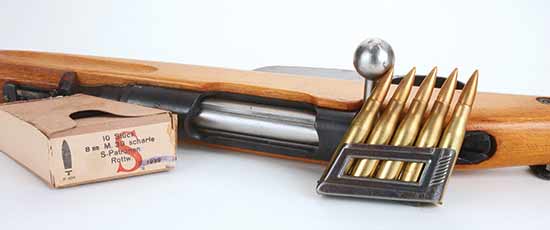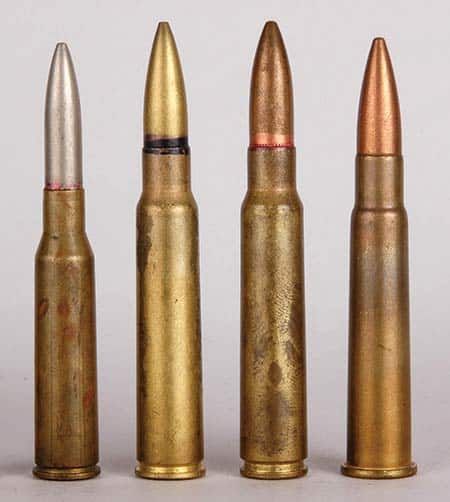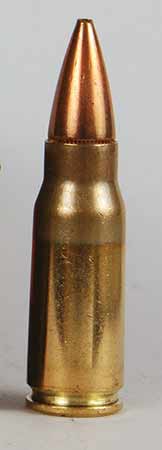Roll Call! World War 2 Rifles
Rifle Calibers Of World War II: A Combatant-By-Combatant Survey
Wherever American troops may find themselves in combat, there’s one thing for certain. They will be fighting with rifles chambered in 5.56mm NATO. And it’s quite likely that their enemies will be firing AK-type rifles chambering the 7.62x39mm or, to a lesser extent, the 5.45x39mm—both creations of the former Soviet Union.
World War II was the last major conflict in which most of the combatant nations fielded shoulder arms designed and produced within their own borders. Those rifles likewise were chambered for domestically developed cartridges. That is one of the reasons why I find WWII history so fascinating.
The variety in WWII rifle calibers is amazing. In bullet size they range from the smallest (Japan’s 6.5×50) to the biggest (the Hungarian 8x56R). In regards to case lengths, the Japanese 6.5×50 is shortest and the United States’ .30-06 is longest at 63mm. Case head configurations included rimless, semi-rimmed and rimmed. Most case shapes were bottleneck, but the aforementioned Hungarian cartridge is actually tapered.
A Silly Millimeter
And, don’t let the basic millimeter designation fool you. For instance, the 6.5×50 Japanese used a 0.264-inch bullet whereas the 6.5×52 Italian used a 0.268-inch projectile. Here’s another example: Germany’s 8×57 takes 0.323-inch bullets but the Hungarian 8x56R uses 0.329-inch ones. That difference is easier to understand when you consider the common European name for Germany’s (and several other nations’) round. Only in the United States is the cartridge referred to as “8mm.” Over there it is 7.92×57.
The so-called .30 calibers also pose some variables. The American .30 caliber uses 0.308-inch bullets—likewise with the French 7.5×54. The Brits’ .303 and Japanese 7.7×58 use 0.311-inch ones and the Soviet’s military Heavy Ball D load had 185-grain bullets measuring 0.310-inch.
All these military cartridges were usually loaded with full metal jacketed (FMJ) bullets, although the Germans and Soviets had the nasty habit of shooting each other with explosive bullets. All standard-issue rounds had spitzer-shaped bullets—except the Italians, who clung to their long roundnose.
Let’s take a look at our WWII cartridge roll call, starting from the smallest and working our way up.
6.5×50 Japanese
Japan’s 6.5×50 was developed as early as 1897 and uses a semi-rimmed case head. By WWII its basic ballistics consisted of a 139-grain bullet at a muzzle velocity of 2,500 fps from the Type 38 rifle’s 31-1/2-inch barrel. Late in the 1930’s the Japanese felt the round was underpowered for combat in China and began developing a new infantry rifle cartridge. But ironically, in the island fighting against American forces, the little 6.5mm made a superb sniper round because the Type 38’s long barrel, coupled with the cartridge’s modest powder capacity, resulted in almost no smoke or muzzle flash.
6.5×52 Italian
As with Japan, Italy was in the process of developing a new military cartridge (the 7.35 Carcano) at the beginning of WWII. Then they decided to stick with their 6.5×50 that dated from 1891. This 6.5 uses a rimless type case head. Its 160-grain RN bullet was rated at 2,300 fps from the 30.7-inch barrel of the Model 1891. An interesting fact? The Caracano’s Mannlicher clip held 6 rounds instead of the traditional 5 of Mauser-type bolt actions.
7.5×54 French
As usual the French insisted on being different when developing their 7.5×54 in the late 1920’s. It has a rimless case unlike any other, but probably closest to the 6.5 Swede. Secondly, the French chose to use a 139-grain .30 caliber bullet at a respectable 2,700 fps, where other users of .30’s and .31’s relied on bullets from 149 to 185 grains.
USA .30-06
America’s .30-06 was the longest of WWII’s infantry rifle cartridges at 63mm. Its rimless case head was copied directly from the 7mm and 8mm Mauser rounds. At least four different rifles so chambered were issued to American combat troops during the war. Two were bolt actions—the Model 1903 Springfield and the Model 1917 Enfield. Two others were semi-autos—the M1 Garand and Model 1941 Johnson, the latter seeing limited use by US Marines early in the war. Two different loads were most often issued during the war to infantry troops. The M2 Ball loading featured a 150-grain spitzer at 2,700 to 2,800 fps. But armor piercing ammunition was also issued in both the Pacific and European theaters. It featured a 165-grain bullet with a hardened steel core at muzzle velocity of 2,715 fps.
7.62x54R Russian
The 7.62x54R has a rimmed case head with wide base tapering to a bottleneck. It was originally introduced in 1891 with the Mosin-Nagant bolt-action rifle. Some sources give proper bullet diameter as 0.308-inch, but more often 0.310-inch is given in reference material. This is supported by the fact the Finns—having captured so much Soviet 7.62x54R ammunition in the 1939/1940 Winter War—increased the barrel groove diameter of their Model 1939 rifles to 0.310-inch so they would be compatible with the captured ammo. The Soviet Union in WWII relied on two basic loads. The Light Ball LP used a 149-grain spitzer at 2,855 fps. The Heavy Ball D featured a 185-grain spitzer at 2,683 fps. The rifles chambered for them were Mosin-Nagant Model 91/30 bolt action and SVT40 semi-auto.
.303 British
The .303 British is another one of those archaic-looking rounds with a rim and tapered case body. It should appear outdated, because it was developed in the black-powder era, circa 1888. Case length is 56mm. As early as the pre-World War I days the British were interested in converting to a .276 caliber cartridge. In fact, the Pattern 1914 was developed to handle its higher pressures. But war in 1914 put those plans on hold. During WWII the British started with their SMLE No. 1 Mk III, which was remodeled into the No. 4 Mk I by 1942. Their standard WWII loading—Mk VII Ball—featured a 175-grain spitzer boattail at a nominal 2,400 fps.
7.7×58 Japanese
Japan’s 7.7×58 case uses the same case head as 7mm, 8mm Mauser and .30-06, although the round itself more closely mirrors the ballistics of the British .303. The standard-issue infantry loading had 184-grain spitzer at 2,400 fps. The rifle co-introduced with the cartridge in 1939 was the Type 99. It was merely a shortened version of the Type 38 with 25-inch barrel. This following information may give a bit of insight as to Japanese logistical affairs circa 1940. They had three 7.7 cartridges with minimal or no interchangeability. The 7.7×58 rimless, meant for the Type 99 rifle (and Type 99 Light Machine Gun), was used by both the Imperial Japanese Army and the Imperial Japanese Navy. But the IJN also used a 7.7×56 Japanese Rimmed in their Type 92 LMG and it was in no way usable in Type 99 rifles or LMG’s. And finally, the Japanese had the Type 92 Heavy Machine Gun used by both the IJA and IJN. Its cartridge was a 7.7×58 semi-rimmed. It has been written that the 7.7×58 semi-rimmed will chamber and fire in Type 99 rifles.
German 8×57 (7.92×57)
Americans call this one the 8mm Mauser, although it wasn’t actually developed by the Mauser firm. Supposedly it was created by German ordnance officers at the end of the black powder era. The 8mm Mauser case head has been copied countless times, but suffice it to say that most American non-magnum sporting rifle cartridges with rimless cases are based upon it. Regardless, up until 1905 bullet diameter was 0.318 inch. In that year—and coincidentally with development of spitzers—bullet diameter was increased to 0.323 inch. As used by Germany through World War I, the standard issue load featured a 154-grain bullet traveling at a very fast 2,880 fps. In the 1930’s, German military loads were changed and bullet weight was increased to 198 grains and velocity reduced to somewhat over 2,500 fps. (Again sources vary, listing speeds from 2,500 to 2,570 fps.) In WWII this load was called “SS Patrone” by the German military. Rifles for it were the ubiquitous K98k of which somewhere between 11,000,000 and 14,000,000 were manufactured in a 10-year time frame. The same loading was used in Germany’s first successful semi-auto infantry rifle—the G43 (later renamed K43).
German 7.92×33 Kurz
Coming along later in WWII was Germany’s revolutionary 7.92×33 Kurz (“short”). It was developed specifically for their revolutionary Sturmgewehr (aka MP43 & MP44). It fired a 123-grain, 0.323-inch bullet at about 2,300 fps. The select-fire “storm rifle” is considered the world’s first assault rifle.
8x56R Hungarian
As an ally of Germany against the Soviet Union, Hungary fielded their Model 95 straight-pull bolt-action rifles and carbines. Mostly these were issued to so-called “police battalions” fighting against partisans in rear areas. As mentioned earlier, this round’s case shape could be termed “tapered” more than “bottlenecked.” It is also rimmed and was directly derived from Austria’s World War I 8x50R. It might have looked old and obsolete, but it certainly was powerful. German-manufactured 8x56R Hungarian ammunition was loaded with 205-grain FMJ bullets rated at from 2,300 to 2,400 fps. Sources on the velocity figure vary—Model 95 rifles have 30-inch barrels, but the 20-inch barreled carbines are far more common (carbines were created by cutting down full-length rifles).
Across The Spectrum
That sums up the most significant WWII infantry rifle cartridges. Most were developed prior to World War I, some even as far back as the 1880’s. To my knowledge, only three came about between the world wars—the 7.5×54 French, 7.7×58 Japanese and 8x56R Hungarian.
All of these calibers are considered obsolete now—at least from a military standpoint. All can be had in commercial sporting ammunition made by one or more manufacturers.

